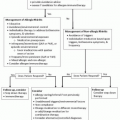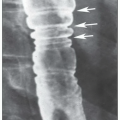|
Clinical Findings |
Lab Findings |
Inheritance |
Molecular Defects |
Predominately antibody deficiencies |
Agammaglobulinemia |
Recurrent and severe bacterial infections, enteroviral infections, absent lymphoid tissue, autoimmunity |
Absent IgM, IgG, and IgA; B cells <1% of lymphocytes; absent specific antibody response |
XL and AR |
X-linked (BTK), autosomal recessive (µ heavy chain, λ5, Igα, Igβ, BLNK) |
Common variable immunodeficiency (CVID) |
Variable phenotype: Recurrent bacterial infections, autoimmune disease, lymphoproliferative and/or granulomatous disease |
Low IgG and IgA and/or IgM; absent specific antibody response; normal or decreased B-cell numbers; variably decreased T-cell responses |
Variable |
Mutations in ICOS, CD19, CD20, CD81, TNFRS-F13B, TNFRSF13C, mostly unknown |
Hyper-IgM syndrome |
Recurrent bacterial infections, opportunistic infections, neutropenia, autoimmune disease, sclerosing cholangitis |
Low IgG and IgA; normal or increased IgM; normal or increased B-cell numbers; decreased T-cell responses in CD40L/CD40 deficiency |
XL and AR |
Mutations in CD40L, CD40, AICDA, UNG |
Selective IgA deficiency |
Usually asymptomatic; some with recurrent bacterial infections, atopy, autoimmunity, and gastrointestinal disorders |
Low/absent IgA; normal IgG and IgM; impaired specific antibody responses in some patients |
Variable |
Unknown |
Specific antibody deficiency |
Recurrent upper respiratory tract infections |
Normal IgG, IgM, and IgA levels; impaired specific antibody response (polysaccharides); normal B-cell numbers |
Variable |
Unknown |
IgG subclass deficiency |
Usually asymptomatic, some with recurrent bacterial infections, atopy, and autoimmunity |
Low levels of one or more IgG subclasses; normal total IgG, IgA, and IgM; normal B-cell numbers; impaired specific antibody responses in some patients |
Variable |
Unknown |
Transient hypogammaglobulinemia of infancy (THI) |
Recurrent upper respiratory tract infections |
Low IgG levels with variably low IgA and rarely low IgM; normal specific antibody responses in most; normal B-cell numbers |
Variable |
Unknown |
Combined T- and B-Cell immunodeficiencies |
T-B+NK-SCID |
Failure to thrive, chronic diarrhea, oral thrush, recurrent and severe bacterial, viral, and/or fungal infections early in life |
Decreased serum immunoglobulins; normal or increased B-cell numbers; markedly decreased T-cell numbers |
XL or AR |
Defects in JAK3, γ-chain of receptors for IL-2, IL-4, IL-7, IL-9, IL-15, IL-21 |
T-B-NK-SCID |
Failure to thrive; chronic diarrhea; recurrent and severe bacterial, viral, and/or fungal infections early in life; costochondral junction flaring; neurologic features; hearing impairment; lung and liver manifestations |
Decreased serum immunoglobulins; absent T- and B-cell numbers |
AR |
Defects in adenosine deaminase |
T-B-NK+SCID |
Failure to thrive, chronic diarrhea, oral thrush, recurrent and severe bacterial, viral, and/or fungal infections early in life; those with Omenn’s syndrome have erythroderma, adenopathy, hepatosplenomegaly, eosinophilia; those with Cernunnos have microcephaly, growth retardation, radiation sensitivity |
Decreased serum immunoglobulins; markedly decreased T- and B-cell numbers |
AR |
Defect in RAG 1/2, Artemis, ligase 4, Cernunnos |
T-B+NK+ SCID |
Failure to thrive, chronic diarrhea, oral thrush, recurrent and severe bacterial, viral, and/or fungal infections early in life |
Decreased serum immunoglobulins; normal or increased B-cell numbers, markedly decreased T-cell numbers |
AR |
IL-7 receptor α-chain |
CD8+CD4-B+NK+ SCID |
Failure to thrive, recurrent and severe bacterial, viral, and/or fungal infections early in life |
Normal or decreased serum immunoglobulins; normal B-cell numbers; decreased CD4 cells; normal CD8 cells |
AR |
Mutations in MHC class II proteins |
CD8-CD4+B+ NK+ SCID |
Failure to thrive, recurrent and severe bacterial, viral, and/or fungal infections early in life |
Normal serum immunoglobulins; normal B-cell numbers; decreased CD8, normal CD4 cells |
AR |
Defects in ZAP70 |
Other immunodeficiencies |
DiGeorge’s syndrome |
Conotruncal malformation; hypoparathyroidism; abnormal facies; absent thymus in complete forms |
Immunoglobulins usually normal though occasionally IgE elevated and IgA reduced; normal B-cell numbers; low to absent T-cell numbers in complete forms; varying degrees of T-cell function according to thymic deficiency |
De novo or AD |
Evidence that point mutations in the TBX1 gene is involved |
Hyper-IgE syndromes |
Distinctive facial features (broad nasal bridge), eczema, osteoporosis, fractures, scoliosis, delayed shedding of primary teeth, bacterial infections (skin and pulmonary abscesses), susceptibility to intracellular bacteria, fungi, and viruses |
Elevated IgE >2,000 IU/mL; eosinophilia in some |
AD or AR |
Mutations in STAT3, TYK2, DOCK8 |
Chronic mucocutaneous candidiasis |
Chronic mucocutaneous candidiasis, autoimmunity |
Normal serum immunoglobulins; normal B-cell numbers; normal T-cell numbers (defect of Th17 cells in CARD9 deficiency) |
AD, AR, sporadic |
Mutations in CARD9 in one family with AR inheritance; AIRE defects in some; unknown in others |
Autoimmune polyendocrinopathy with candidiasis and ectodermal dystrophy (APECED) |
Autoimmune disease (usually parathyroid and adrenal), candidiasis, dental enamel hypoplasia |
Normal T- and B-cell numbers; organ-specific autoantibodies |
AR |
Defects in AIRE |
X-linked lymphoproliferative (XLP) |
Clinical and immunologic abnormalities triggered by EBV infection; hepatitis, aplastic anemia, lymphoma |
Normal or low immunoglobulins; normal T-cell numbers; normal or reduced B-cell numbers |
XL |
Defects in SH2D1A, XIAP |
Immune dysregulation, polyendocrinopathy, enteropathy, X-linked (IPEX) |
Autoimmune diarrhea, early-onset diabetes, thyroiditis, hemolytic anemia, thrombocytopenia, eczema |
Elevated IgA and IgE; normal B-cell numbers; lack of CD4+CD25+ FOXP3+ regulatory T cells; eosinophilia |
XL |
Defects in FOXP3 |
Ataxia-telangiectasia |
Ataxia, telangiectasia, pulmonary infections, lymphoreticular and other malignancies, increased x-ray sensitivity, chromosomal instability |
Often low IgA, IgE, and IgG subclasses; increased IgM monomers; antibodies variably decreased; normal B-cell numbers; progressive decline in T-cell numbers; increased alpha fetoprotein |
AR |
Mutations in ATM |
Autoimmune lymphoproliferative syndrome (ALPS) |
Splenomegaly, adenopathy, autoimmune blood cytopenias, defective lymphocyte apoptosis |
Increased double-negative T cells; normal B-cell numbers |
AD or AR |
Defects in TNFRSF6, CASP10, CASP8, NRAS |
Wiskott-Aldrich syndrome |
Thrombocytopenia, eczema, autoimmune disease, bacterial and viral infections, lymphoreticular malignancy |
Decreased IgM; often increased IgA and IgE; antibody response to polysaccharides decreased; normal B-cell numbers; progressive decrease in T-cell numbers with abnormal lymphocyte responses to anti-CD3 |
XL |
Mutations in WAS |
Chronic granulomatous disease (CGD) |
Diarrhea, colitis, hepatomegaly, splenomegaly, granulomas, abscess, skin infections, recurrent bacterial and fungal infections (Staphylococcus aureus and Aspergillus) |
Defective oxidative burst by DHR or NBT equivalent |
XL or AR |
Mutations in CYBA, CYBB, NCF1, NCF2 |
Abbreviations: AD, autosomal dominant inheritance; AICDA, activation-induced cytidine deaminase; AIRE, autoimmune regulator; AR, autosomal recessive inheritance; ATM, ataxia-telangiectasia mutated; BLNK, B-cell linker protein; BTK, Bruton’s tyrosine kinase; CARD9; caspase recruitment domain-containing protein 9; CASP, caspase; CYBA, cytochrome b alpha subunit; CYBB, cytochrome b beta subunit; DHR, dihydrorhodamine; DOCK8, dedicator of cytokinesis; FOXP3, forkhead box protein 3; ICOS, inducible costimulator; JAK3, Janus kinase 3; MHC II, major histocompatibility complex class II; NBT; nitroblue tetrazolium; NRAS, neuroblastoma RAS protein; RAG, recombination activating gene; SH2D1A, SH2 domain protein 1A; STAT3, signal transducer and activator of transcription 3; TBX1, T-box 1; TNFRSF, tumor necrosis factor receptor superfamily; TYK2, tyrosine kinase 2; UNG, uracil-DNA glycosylase; WAS, Wiskott-Aldrich syndrome; XL, XIAP, X-linked inhibitor of apoptosis; X-linked inheritance; ZAP70, zeta chain-associated protein kinase, 70kD |







